Chemical and Structural Characterization of Amorphous and Crystalline Alumina Obtained by Alternative Sol–Gel Preparation Routes
Abstract
:1. Introduction
- Hydrolysis of precursors and condensation followed by polycondensation (i.e., formation of sol),M(H2O)nz+ + H2O → M(OH)(H2O)n(z − 1)+ + H3O+ (aqueous phase)
(1)–M–OR + H2O → –M–OH + ROH (organic phase) - Condensation:where M refers to metal atom, R to alkyl groups and n to metal valency. The rate of these reactions can be controlled by changing pH. In addition, parameters such as temperature, humidity, stirring speed, solubility of the reagents and other factors may have impact on the process [18].2[M(OH)(H2O)n(z − 1)+] → [M–O–M(OH)2(H2O)2n − 1]2(z − 1)+ + H2O (aqueous phase)
–M–OH + RO–M → –M–O–M– + ROH
or
–M–OH + HO–M → –M–O–M– + H2O (organic phase)
- 3.
- Gelation, known as sol–gel transformation, which leads to the formation of a jelly like substance—a gel of high softness.
2. Materials and Methods
2.1. Sols Preparation
2.2. Powder Preparation
2.3. SEM
2.4. XRD
2.5. FTIR and DRIFT
2.6. NMR
2.7. BET
3. Results and Discussion
3.1. SEM and EDX Analysis
3.2. FTIR
3.3. DRIFTS
3.4. XRD
3.5. Temperature XRD
3.6. NMR
3.7. Thermal Analysis TG, DTG, DSC
3.8. BET Examination
4. Conclusions
Author Contributions
Funding
Institutional Review Board Statement
Informed Consent Statement
Data Availability Statement
Conflicts of Interest
References
- Abyzov, A.M. Aluminum Oxide and Alumina Ceramics (review). Part 1. Properties of Al2O3 and Commercial Production of Dispersed Al2O3. Refract. Ind. Ceram. 2019, 60, 24–32. [Google Scholar] [CrossRef]
- Busca, G. Structural, Surface, and Catalytic Properties of Aluminas. Adv. Catal. 2014, 57, 319–404. [Google Scholar]
- Liu, L.; Corma, A. Metal Catalysts for Heterogeneous Catalysis: From Single Atoms to Nanoclusters and Nanoparticles. Chem. Rev. 2018, 118, 4981–5079. [Google Scholar] [CrossRef] [PubMed] [Green Version]
- Surmacz, P.; Kostecki, M.; Gut, Z.; Olszyna, A. Aluminum Oxide–Supported Manganese Oxide Catalyst for a 98% Hydrogen Peroxide Thruster. J. Propuls. Power 2019, 35, 1–10. [Google Scholar] [CrossRef]
- Rechner, R.; Jansen, I.; Beyer, E. Optimization of the aluminum oxide properties for adhesive bonding by laser surface pretreatment. J. Laser Appl. 2012, 24, 032002. [Google Scholar] [CrossRef]
- Campbell, R.J.; Kroontje, W. Evaporation Studies of the Sintered Aluminum Oxide Discharge Tubes Used in High Pressure Sodium (HPS) Lamps. LEUKOS 2013, 9, 233–239. [Google Scholar] [CrossRef]
- Bolat, S.; Torres Sevilla, G.; Mancinelli, A.; Gilshtein, E.; Sastre, J.; Vidani, A.C.; Bachmann, D.; Shorubalko, I.; Briand, D.; Tiwari, A.N.; et al. Synaptic transistors with aluminum oxide dielectrics enabling full audio frequency range signal processing. Sci. Rep. 2020, 10, 16664. [Google Scholar] [CrossRef]
- Yoshimura, H.N.; Abreu, A.P.; Molisani, A.L.; de Camargo, A.C.; Portela, J.C.S.; Narita, N.E. Evaluation of aluminum dross waste as raw material for refractories. Ceram. Int. 2008, 34, 581–591. [Google Scholar] [CrossRef]
- Ramírez, M.; González, R.I.; Baltazar, S.E.; Rojas-Nunez, J.; Allende, S.; Valdivia, J.A.; Rogan, J.; Kiwi, M.; Valencia, F.J. Thermal stability of aluminum oxide nanoparticles: Role of oxygen concentration. Inorg. Chem. Front. 2019, 6, 1701–1706. [Google Scholar] [CrossRef]
- Xiong, H.; Zhang, Y.; Wang, S.; Li, J. Fischer-Tropsch synthesis: The effect of Al2O3 porosity on the performance of Co/Al2O3 catalyst. Catal. Commun. 2005, 6, 512–516. [Google Scholar] [CrossRef]
- Vieira Coelho, A.C.; de Souza Santos, H.; Kiyohara, P.K.; Marcos, K.N.P.; de Souza Santos, P. Surface area, crystal morphology and characterization of transition alumina powders from a new gibbsite precursor. Mater. Res. 2007, 10, 183–189. [Google Scholar] [CrossRef] [Green Version]
- Védrine, J.C. Heterogeneous catalysis on metal oxides. Catalysts 2010, 7, 341. [Google Scholar] [CrossRef] [Green Version]
- Lytvynov, L. Aluminum oxide. In Single Crystals of Electronic Materials: Growth and Properties; Woodhead Publishing: Cambridge, UK, 2018; pp. 447–483. [Google Scholar]
- Hartmann, S.; Sachse, A.; Galarneau, A. Challenges and Strategies in the Synthesis of Mesoporous Alumina Powders and Hierarchical Alumina Monoliths. Materials 2012, 5, 336–349. [Google Scholar] [CrossRef]
- Rutkowska, I.; Gawȩda, M.; Długoń, E.; Sitarz, M. Obtaining alumina coatings on steel substrates by electrodeposition and sol-gel methods. In Proceedings of the METAL 2018—27th International Conference on Metallurgy and Materials, Conference Proceedings, Brno, Czech Republic, 23–25 May 2018; TANGER Ltd.: Brno, Czech Republic, 2018; pp. 953–958. [Google Scholar]
- Danks, A.E.; Hall, S.R.; Schnepp, Z. The evolution of ‘sol-gel’ chemistry as a technique for materials synthesis. Mater. Horiz. 2016, 3, 91–112. [Google Scholar] [CrossRef] [Green Version]
- Shaheen, I.; Ahmad, K.S.; Zequine, C.; Gupta, R.K.; Thomas, A.G.; Malik, M.A. Modified sol-gel synthesis of Co3O4 nanoparticles using organic template for electrochemical energy storage. Energy 2021, 218, 119502. [Google Scholar] [CrossRef]
- Alves, A.K.; Berutti, F.A.; Bergmann, C.P. The effects of pH on the preparation of alumina by sol-gel process. Part. Sci. Technol. 2005, 23, 351–360. [Google Scholar] [CrossRef]
- Pierre, A.C. Introduction to Sol-Gel Processing; Springer: Cham, Switzerland, 2020; pp. 119–158. [Google Scholar]
- Brinker, C.J.; Scherer, G.W. Sol-Gel Science: The Physics and Chemistry of Sol-Gel Processing; Academic Press: Boston, MA, USA, 2013; pp. 236–269. [Google Scholar]
- Akia, M.; Alvi, S.M.; Rezaei, M.; Yan, Z.F. Optimizing the sol–gel parameters on the synthesis of mesostructure nanocrystalline γ-Al2O3. Microporous Mesoporous Mater. 2009, 122, 72–78. [Google Scholar] [CrossRef]
- Kim, S.M.; Lee, Y.J.; Bae, J.W.; Potdar, H.S.; Jun, K.W. Synthesis and characterization of a highly active alumina catalyst for methanol dehydration to dimethyl ether. Appl. Catal. A Gen. 2008, 348, 113–120. [Google Scholar] [CrossRef]
- Nguefack, M.; Popa, A.F.; Rossignol, S.; Kappenstein, C. Preparation of alumina through a sol-gel process. Synthesis, characterization, thermal evolution and model of intermediate boehmite. Phys. Chem. Chem. Phys. 2003, 5, 4279–4289. [Google Scholar] [CrossRef]
- Boumaza, A.; Favaro, L.; Ledion, J.; Sattonnay, G.; Berthet, P.; Tétot, R. Transition alumina phases induced by heat treatment of boehmite: An X-ray diffraction and infrared spectroscopy study. J. Solid State Chem. 2009, 182, 1171–1176. [Google Scholar] [CrossRef]
- Yoldas, B.E. Hydrolysis of aluminum alkoxides and bayerite conversion. J. Appl. Chem. Biotechnol. 1973, 23, 803–809. [Google Scholar] [CrossRef]
- Yoldas, B.E. Alumina gels that form porous transparent Al2O3. J. Mater. Sci. 1975, 10, 856–860. [Google Scholar] [CrossRef]
- Yoldas, B.E. Alumina sol preparation from alkoxides. Am. Ceram. Soc. Bull. 1975, 54, 289–290. [Google Scholar]
- Ji, L.; Lin, J.; Tan, K.L.; Zeng, H.C. Synthesis of high-surface-area alumina using aluminum tri-sec-butoxide-2,4-pentanedione-2-propanol-nitric acid precursors. Chem. Mater. 2000, 12, 931–939. [Google Scholar] [CrossRef]
- Trueba, M.; Trasatti, S.P. γ-alumina as a support for catalysts: A review of fundamental aspects. Eur. J. Inorg. Chem. 2005, 17, 3393–3403. [Google Scholar] [CrossRef]
- Gangwar, J.; Gupta, B.K.; Tripathi, S.K.; Srivastava, A.K. Phase dependent thermal and spectroscopic responses of Al2O3 nanostructures with different morphogenesis. Nanoscale 2015, 7, 13313–13344. [Google Scholar] [CrossRef]
- Colomban, P. Structure of oxide gels and glasses by infrared and Raman scattering. J. Mater. Sci. 1989, 24, 3011–3020. [Google Scholar] [CrossRef]
- Kiss, A.B.; Keresztury, G.; Farkas, L. Raman and i.r. spectra and structure of boehmite (γ-AlOOH). Evidence for the recently discarded D172h space group. Spectrochim. Acta Part A Mol. Spectrosc. 1980, 36, 653–658. [Google Scholar] [CrossRef]
- Zhang, H.; Li, P.; Cui, W.; Liu, C.; Wang, S.; Zheng, S. Synthesis of nanostructured γ-AlOOH and its accelerating behavior on the thermal decomposition of AP. RSC Adv. 2016, 6, 27235–27241. [Google Scholar] [CrossRef]
- Saniger, J.M. Al-O infrared vibrational frequencies of γ-alumina. Mater. Lett. 1995, 22, 109–113. [Google Scholar] [CrossRef]
- Segal, F.M.; Correa, M.F.; Bacani, R.; Castanheira, B.; Politi, M.J.; Brochsztain, S.; Triboni, E.R. A novel synthesis route of mesoporous γ-alumina from polyoxohydroxide aluminum. Mater. Res. 2018, 21, e20170674. [Google Scholar] [CrossRef] [Green Version]
- Ates, M.; Demir, V.; Arslan, Z.; Daniels, J.; Farah, I.O.; Bogatu, C. Evaluation of alpha and gamma aluminum oxide nanoparticle accumulation, toxicity, and depuration in Artemia salina larvae. Environ. Toxicol. 2015, 30, 109–118. [Google Scholar] [CrossRef] [PubMed] [Green Version]
- Naskar, M.K. Soft solution processing for the synthesis of alumina nanoparticles in the presence of glucose. J. Am. Ceram. Soc. 2010, 93, 1260–1263. [Google Scholar] [CrossRef]
- Digne, M.; Sautet, P.; Raybaud, P.; Euzen, P.; Toulhoat, H. Hydroxyl groups on γ-alumina surfaces: A DFT study. J. Catal. 2002, 211, 1–5. [Google Scholar] [CrossRef]
- Zanganeh, N.; Zanganeh, S.; Rajabi, A.; Allahkarami Masoud, M.; Rahbari Ghahnavyeh Reza, R.; Moghaddas Arshak, A.; Aieneravaie Morteza, M.; Asadizanjani, N.; Sadrnezhaad, S.K. Flower-like boehmite nanostructure formation in two-steps. J. Coord. Chem. 2014, 67, 555–562. [Google Scholar] [CrossRef]
- Hilmen, A.M.; Bergene, E.; Lindvåg, O.A.; Schanke, D.; Eri, S.; Holmen, A. Fischer-Tropsch synthesis on monolithic catalysts of different materials. Catal. Today 2001, 27, 227–232. [Google Scholar] [CrossRef]
- Sarou-Kanian, V.; Gleizes, A.N.; Florian, P.; Samélor, D.; Massiot, D.; Vahlas, C. Temperature-dependent 4-, 5- and 6-fold coordination of aluminum in MOCVD-grown amorphous alumina films: A very high field 27Al-NMR study. J. Phys. Chem. C 2013, 117, 21965–21971. [Google Scholar] [CrossRef] [Green Version]
- O’Dell, L.A.; Savin, S.L.P.; Chadwick, A.V.; Smith, M.E. A 27Al MAS NMR study of a sol-gel produced alumina: Identification of the NMR parameters of the θ-Al2O3 transition alumina phase. Solid State Nucl. Magn. Reson. 2007, 31, 169–173. [Google Scholar] [CrossRef]
- Lee, S.K.; Lee, S.B.; Park, S.Y.; Yi, Y.S.; Ahn, C.W. Structure of amorphous aluminum oxide. Phys. Rev. Lett. 2009, 1–4. [Google Scholar] [CrossRef]
- Samain, L.; Jaworski, A.; Edén, M.; Ladd, D.M.; Seo, D.-K.; Garcia-Garcia, F.J.; Häussermann, U. Structural analysis of highly porous γ-Al2O3. J. Solid State Chem. 2014, 217, 1–8. [Google Scholar] [CrossRef]
- Su, Q.; Zhang, S.; Chen, P.; Li, X.; Fu, J.; Ma, L. Characterization and analysis on the thermal transformation of boehmite synthesized by yoldas method. Adv Mat Res. 2012, 532–533, 3–7. [Google Scholar] [CrossRef]
- Zhu, B.; Fang, B.; Li, X. Dehydration reactions and kinetic parameters of gibbsite. Ceram. Int. 2010, 36, 2493–2498. [Google Scholar] [CrossRef]
- Deng, Z.Y.; Fukasawa, T.; Ando, M.; Zhang, G.J.; Ohji, T. High-Surface-Area Alumina Ceramics Fabricated by the Decomposition of Al(OH)3. J. Am. Ceram. Soc. 2001, 84, 485–491. [Google Scholar] [CrossRef]
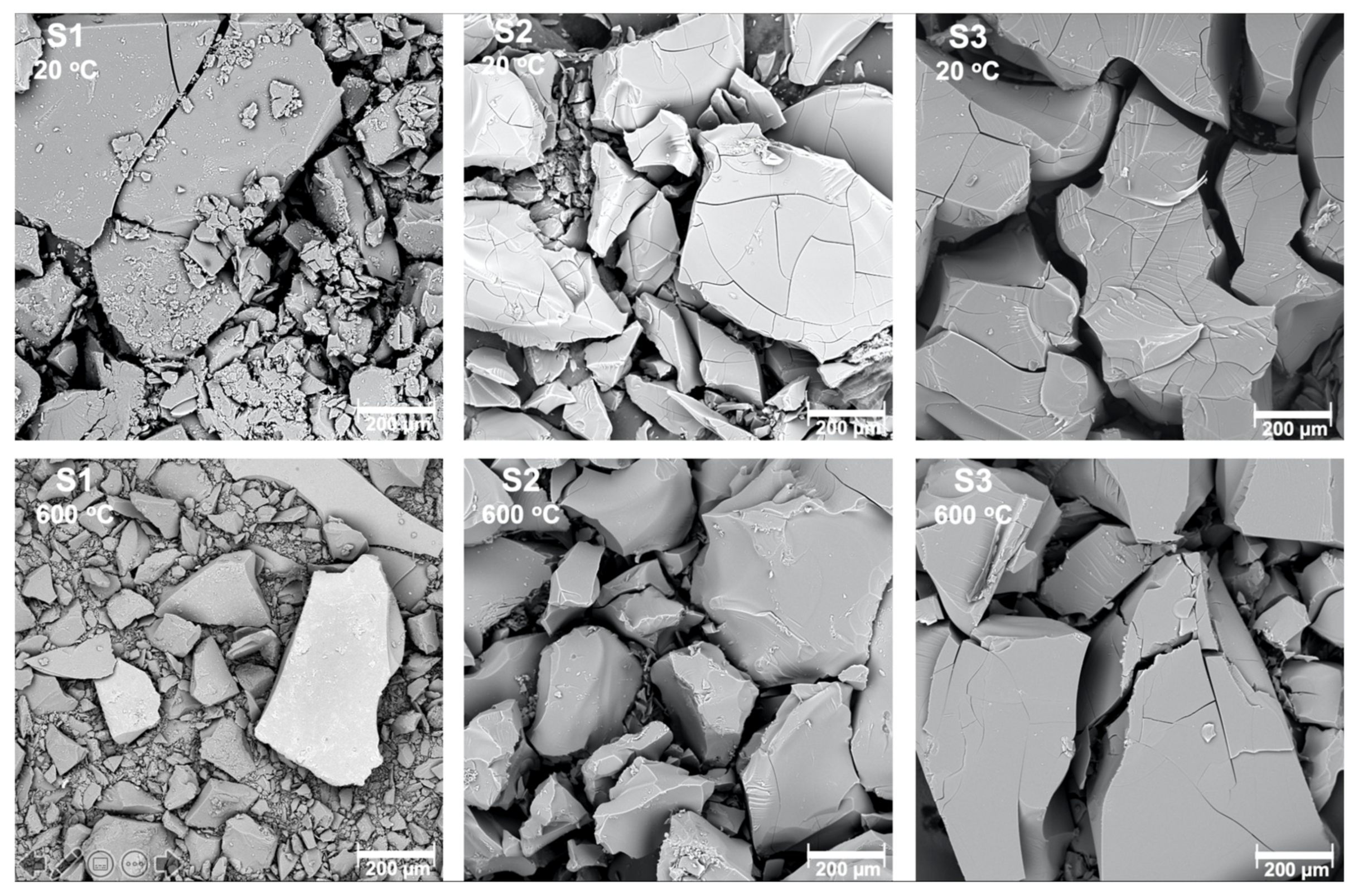
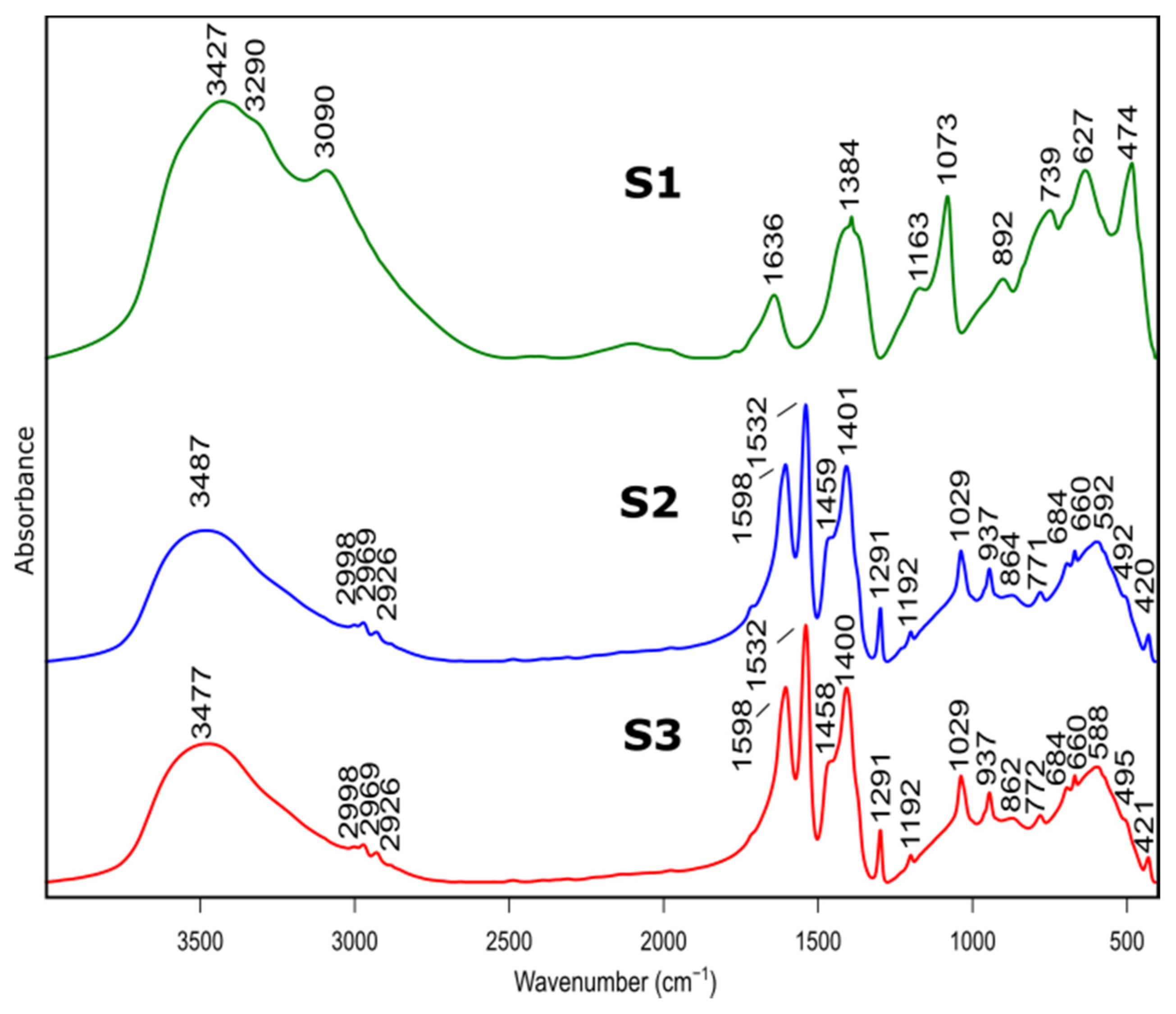
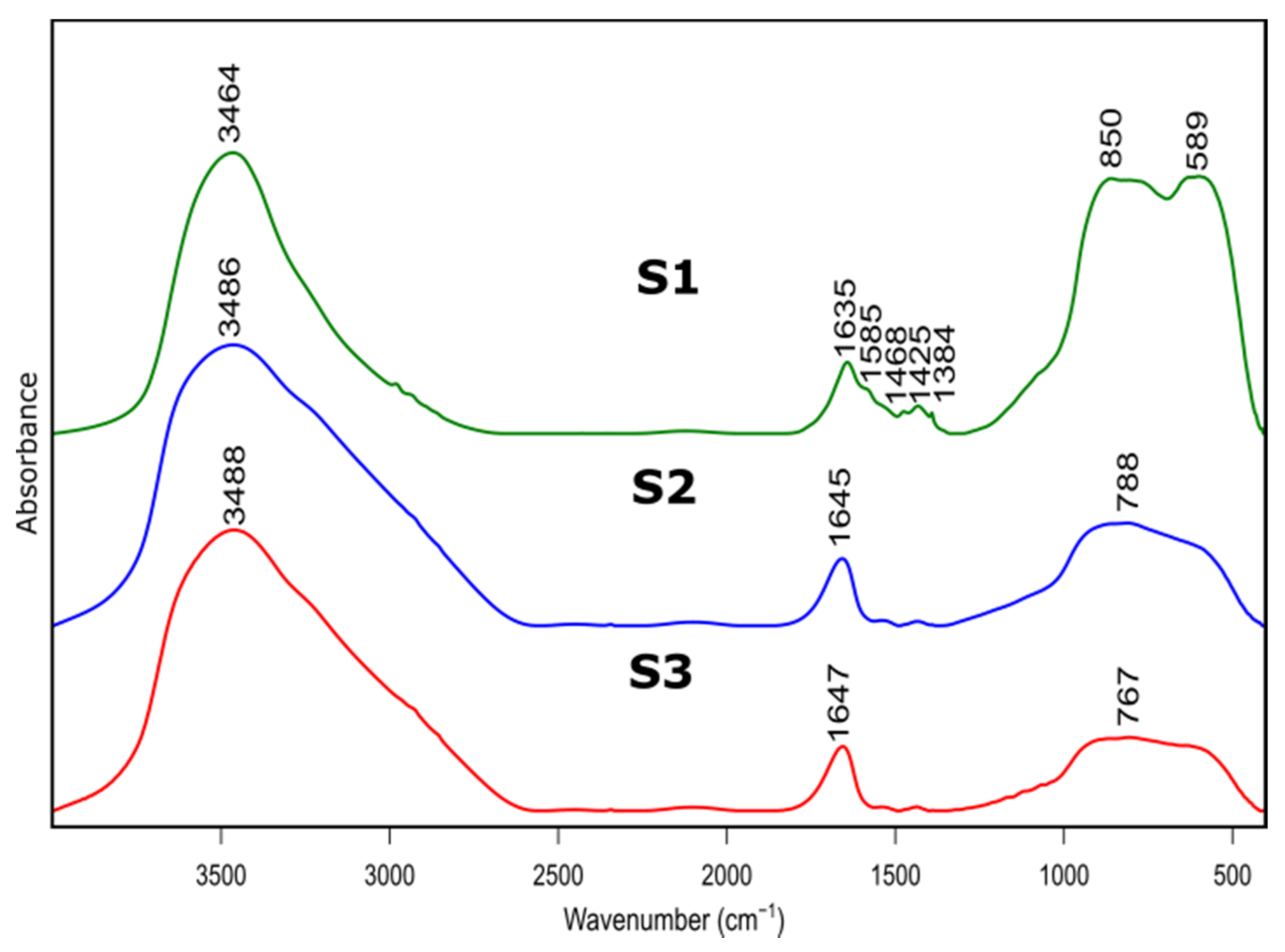

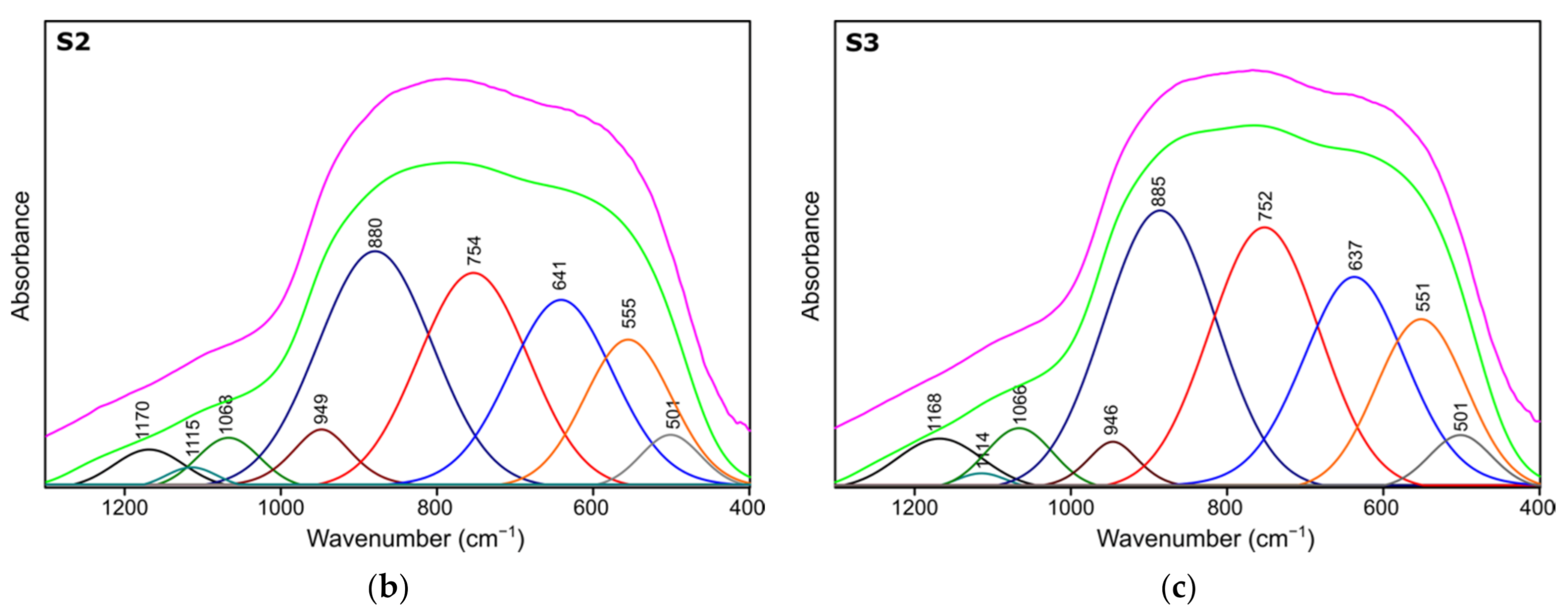
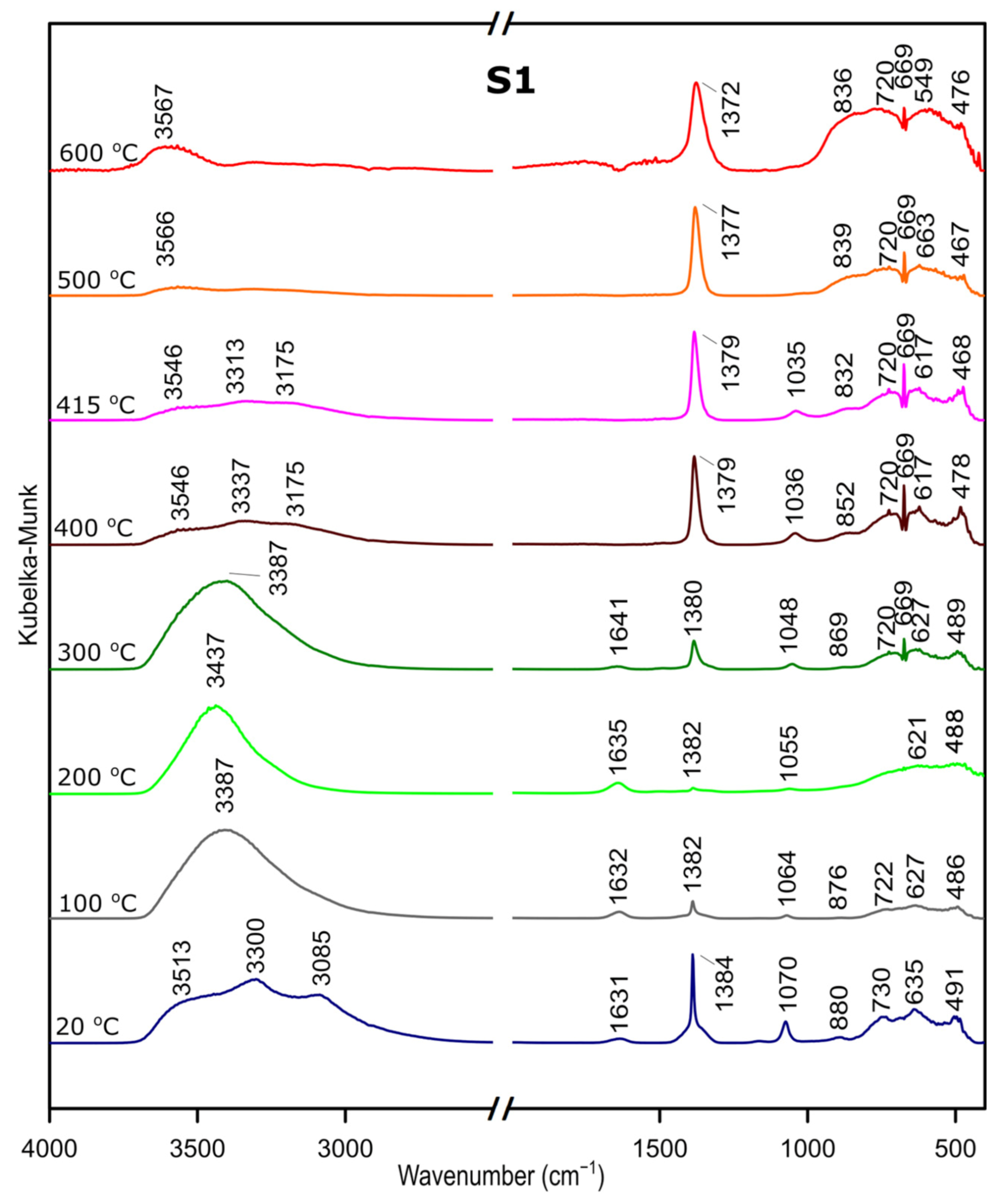
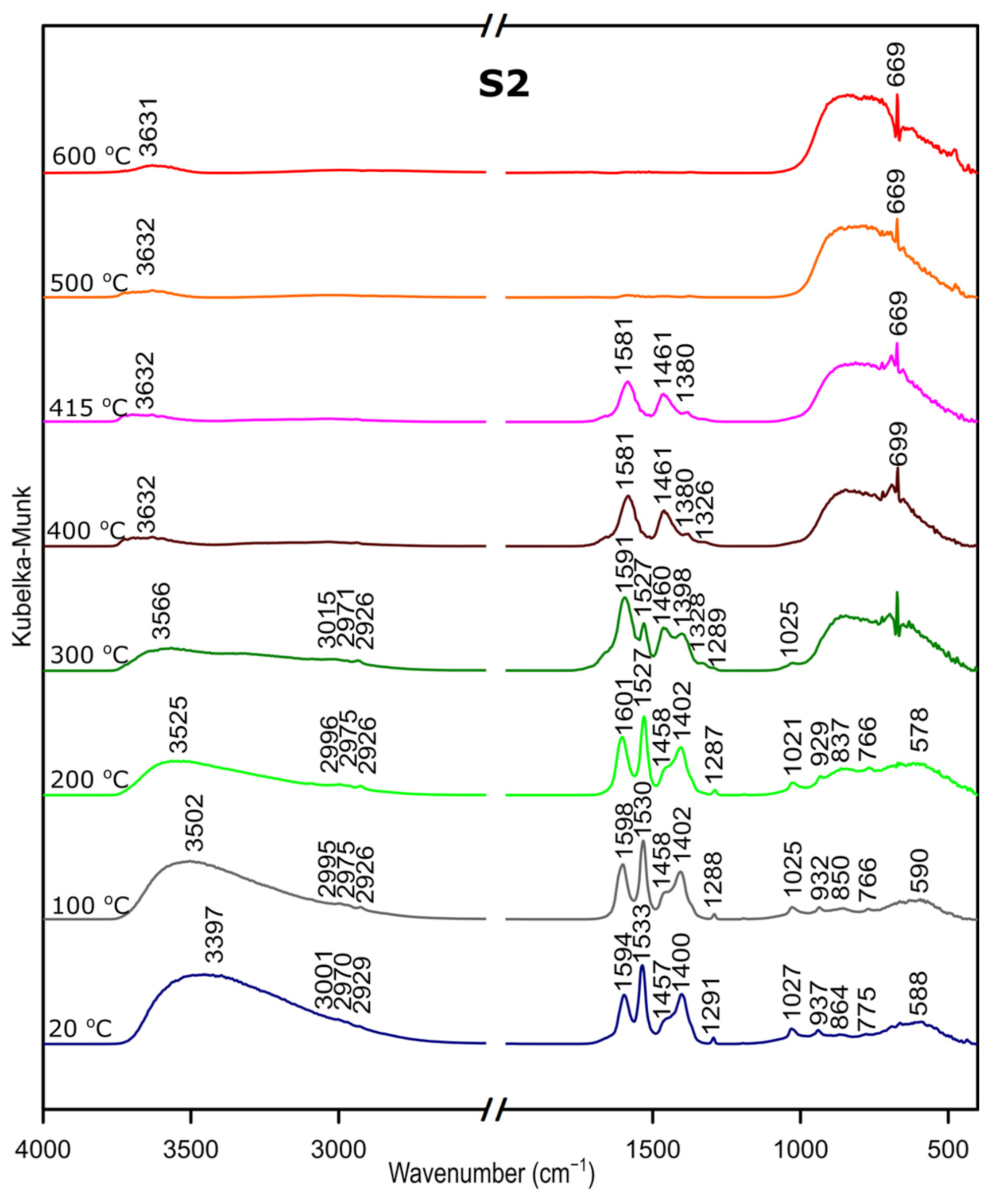

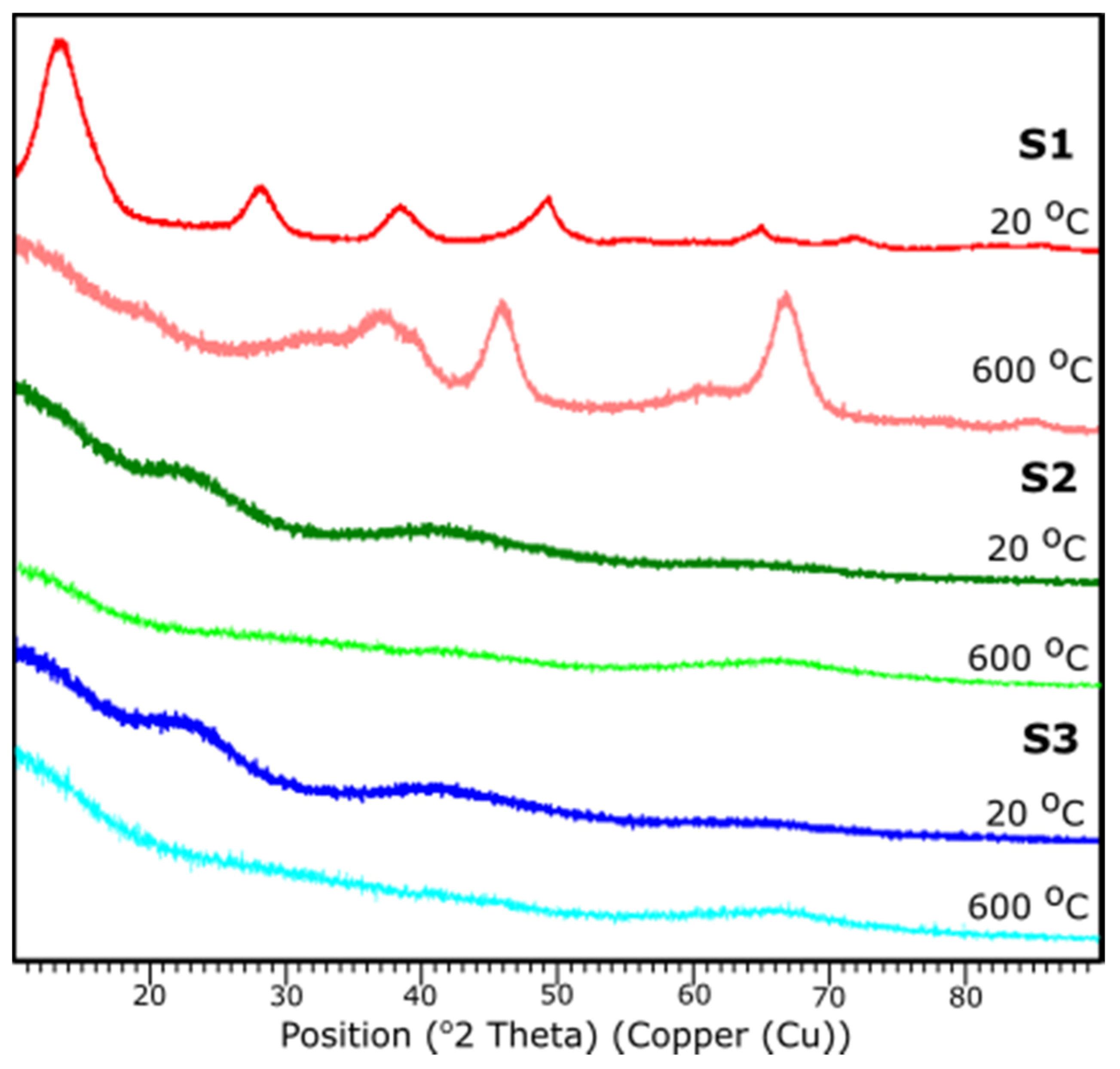
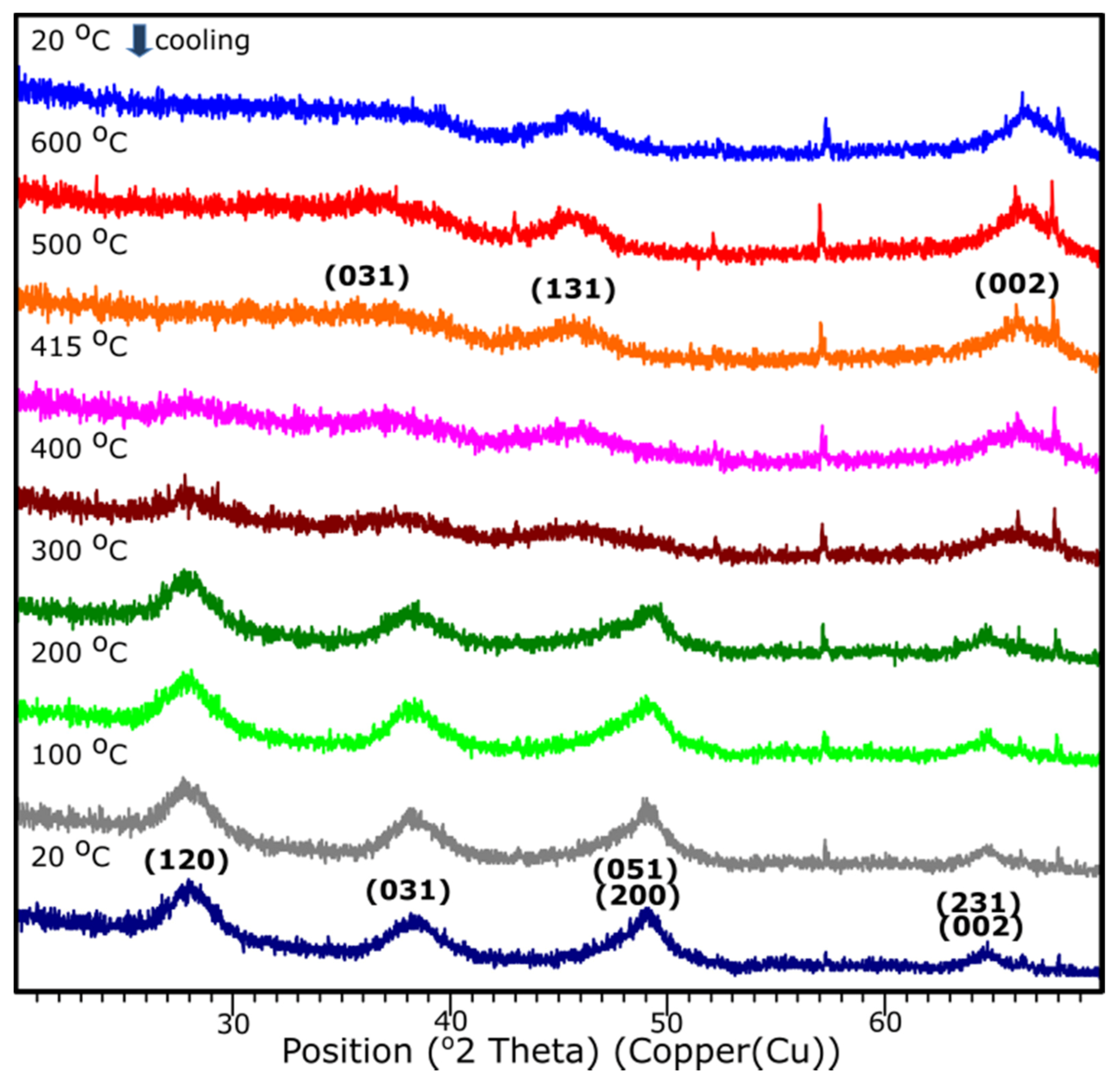
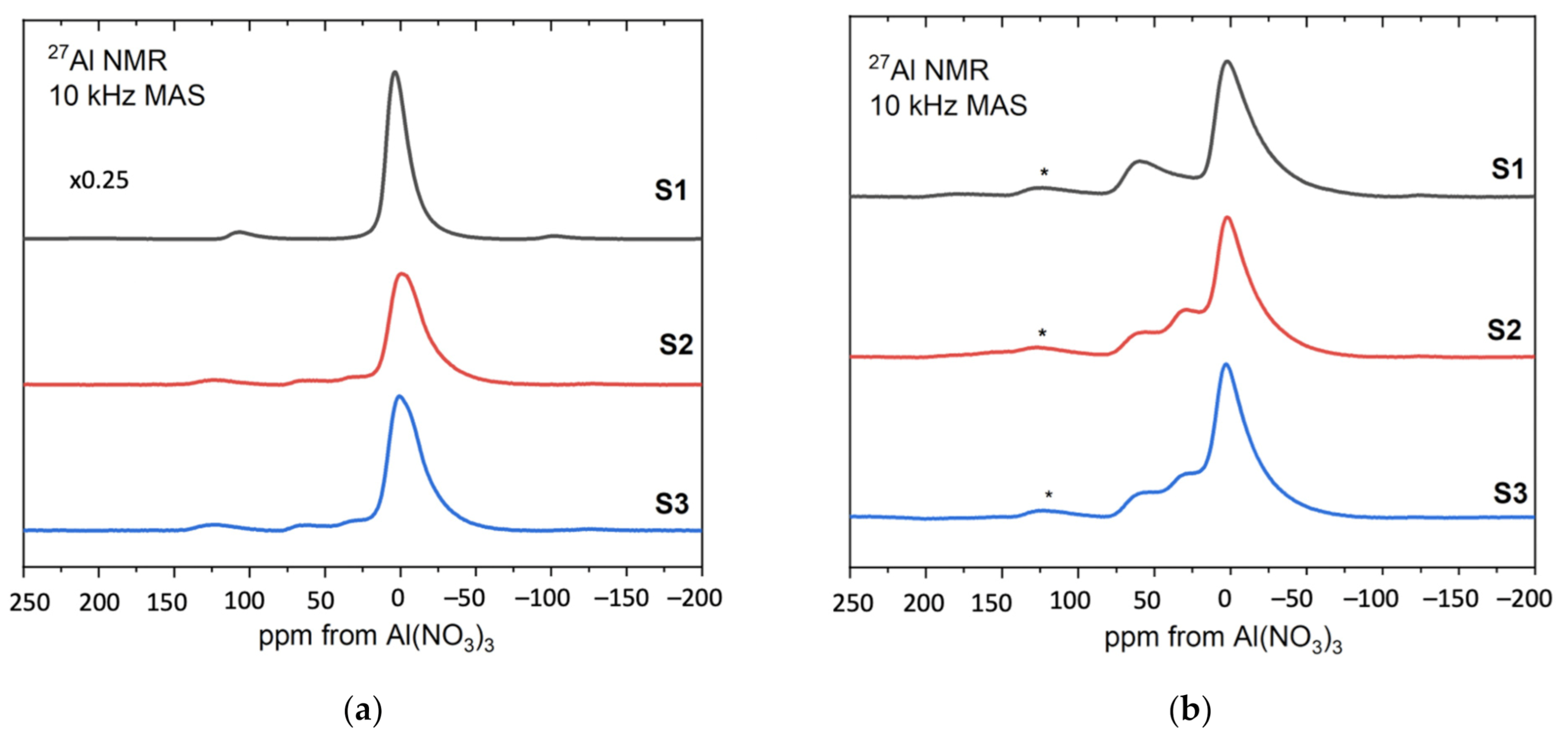
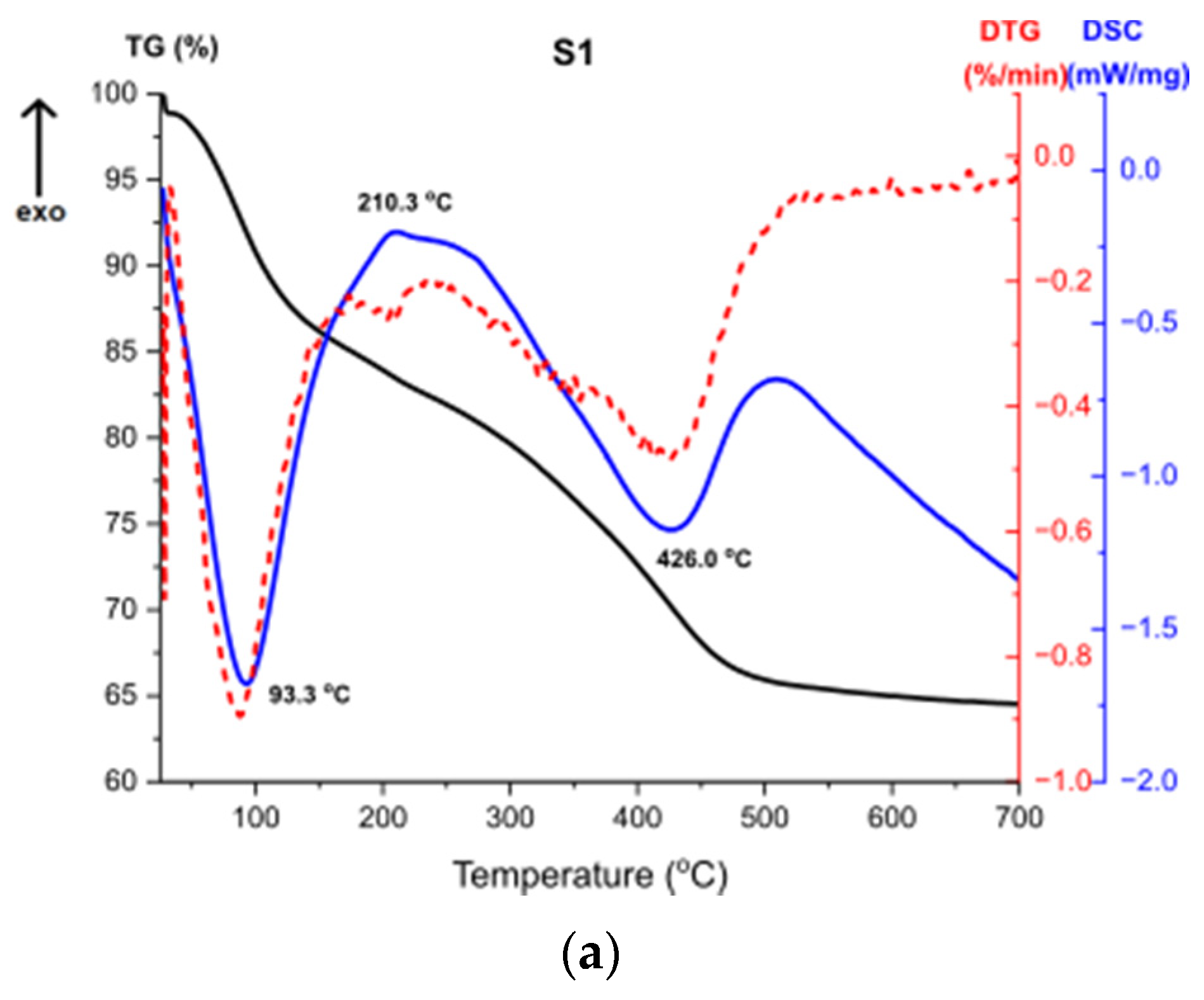
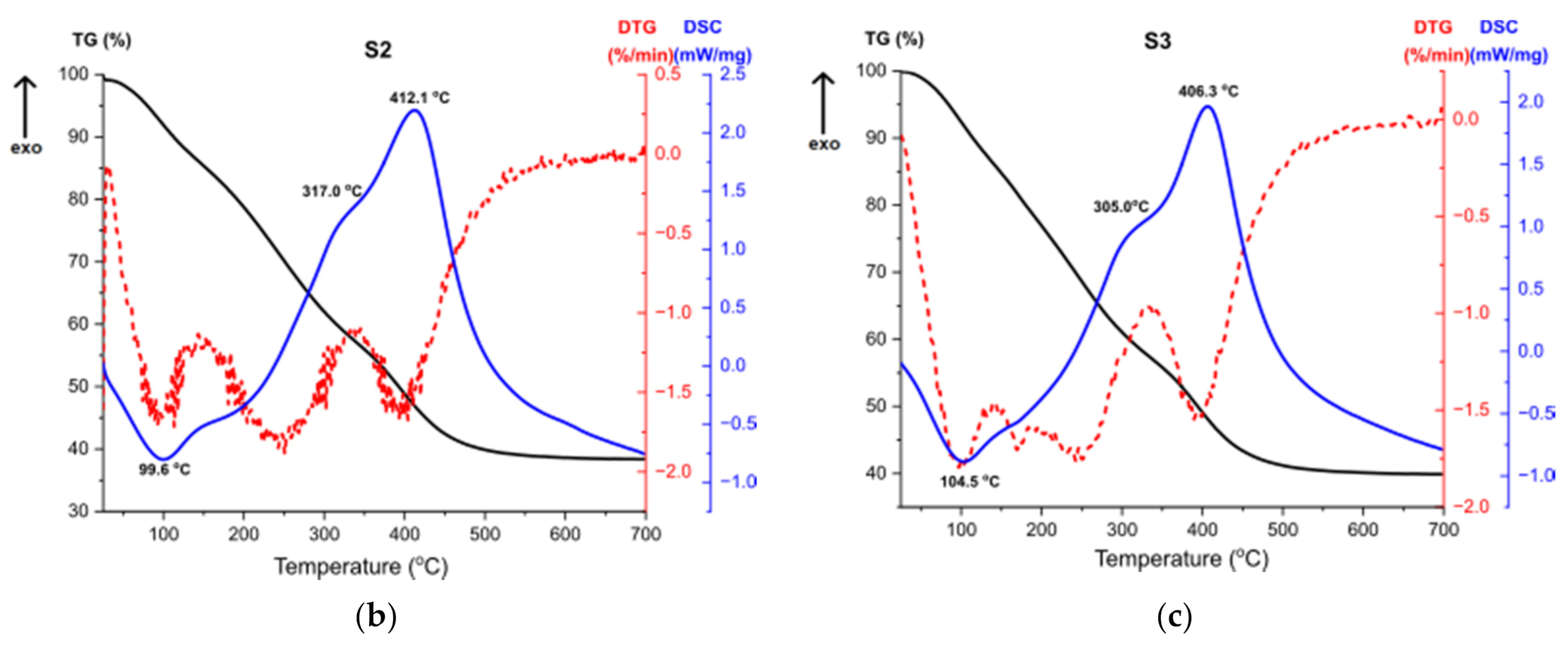
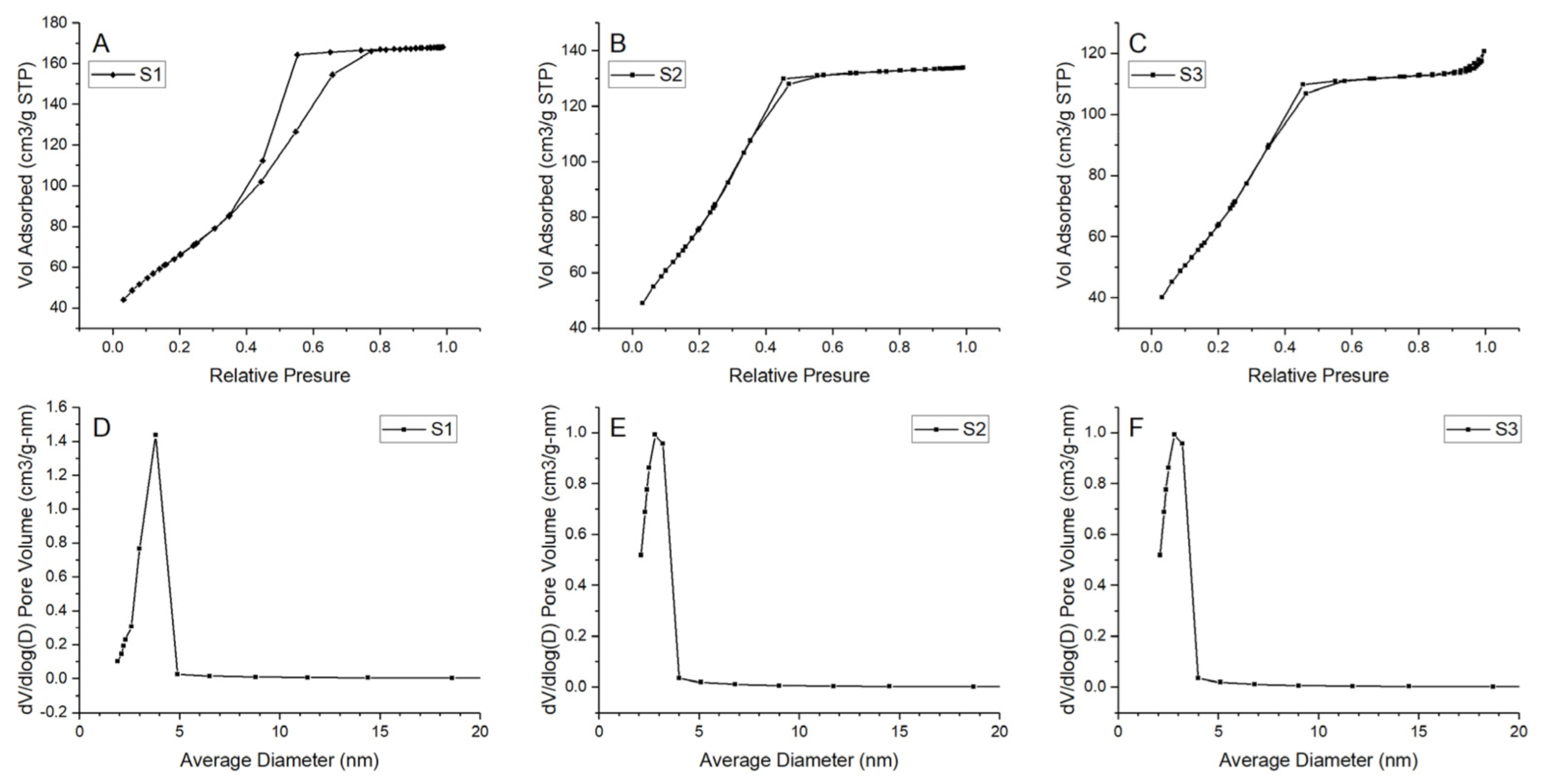
| S1 20 °C | Al | O | S1 600 °C | Al | O |
|---|---|---|---|---|---|
| At% | 33.07 | 66.93 | At% | 38.16 | 61.84 |
| Wt% | 45.45 | 54.55 | Wt% | 50.99 | 49.01 |
| S2 20 °C | Al | O | S2 600 °C | Al | O |
| At% | 26.42 | 73.58 | At% | 36.62 | 63.38 |
| Wt% | 37.72 | 62.28 | Wt% | 49.35 | 50.65 |
| S3 20 °C | Al | O | S3 600 °C | Al | O |
| At% | 26.28 | 73.72 | At% | 38.07 | 61.93 |
| Wt% | 37.55 | 62.45 | Wt% | 50.90 | 49.10 |
| S1 (cm−1) | S2 (cm−1) | S3 (cm−1) | Type of Vibration |
|---|---|---|---|
| 3427 s, br | 3481 s, br | 3474 s, br | νas and νs O-H in H2O |
| 3290 s, sh | - | - | νas OH in AlOOH |
| 3090 s | - | - | νs OH in AlOOH |
| - | 2998 w | 2998 w | ν C-H in Al(acac)3 |
| - | 2969 w | 2969 w | ν C-H in Al(acac)3 |
| - | 2926 w | 2926 w | ν C-H in Al(acac)3 |
| 1636 m | δs H-O-H in H2O | ||
| - | 1598 s | 1598 s | ν C = O in Al(acac)3 |
| - | 1532 vs | 1532 vs | ν C = O in Al(acac)3 |
| - | 1459 m, sh | 1458 m, sh | δ C-H in Al(acac)3 |
| - | 1401 s | 1400 s | δ C-H in Al(acac)3 |
| 1384 m | - | - | νas N-O in NO3− |
| - | 1291 m | 1291 | ν C-C in Al(acac)3 |
| - | 1192 | 1192 | δ C-CH3 in Al(acac)3 |
| 1163 m, sh | - | - | δas OH of Al-O-H in AlOOH |
| 1073 m | - | - | δs OH of Al-O-H in AlOOH |
| - | 1029 m | 1029 m | δ C-CH3 in Al (acac)3 |
| - | 937 m | 937 m | ν C-CH3 in Al(acac)3 |
| 892 m | - | - | νs N-O in NO3− |
| - | 864 w | 862 w | ν Al-O of [AlO4] in Al2O3 |
| - | 771 w | 772 w | ν Al-O of [AlO4] in Al2O3 |
| 739 m | - | - | ν Al-O of [AlO6] in AlOOH |
| - | 684 w | 684 w | ν Al-O of [AlO6] in Al2O3 |
| - | 660 w | 660 w | ν Al-O of [AlO6] in Al2O3 |
| 627 s | - | - | ν Al-O of [AlO6] in AlOOH |
| - | 592 m | 588 m | ν Al-O of [AlO6] in Al2O3 |
| - | 492 w, sh | 495 w, sh | ν Al-O-C in Al(acac)3 |
| 474 s | - | - | δ Al-O of [AlO6] in AlOOH |
| - | 420 w | 421 w | δ Al-O-C in Al(acac)3 |
| S1 (cm−1) | S2 (cm−1) | S3 (cm−1) | Type of Vibration |
|---|---|---|---|
| 3464 s, br | 3486 s, br | 3488 s, br | νas and νs O-H in H2O |
| 1635 m | 1645 m | 1647 m | δs H-O-H in H2O |
| 1468 m | - | - | νas N-O in NO3− |
| 850 w | - | - | δs or ν Al-O of [AlO4] in Al2O3 combined bands |
| - | 788 w | 767 w | ν Al-O of [AlO4] in Al2O3 combined bands |
| 589 w | - | - | ν Al-O of [AlO6] in Al2O3 octahedral and tetrahedral |
| Sample | Band Assignment | νas Al-O [AlO6]/ δ Al-O [33,34] | ν Al-O of [AlO6] [35] | νs Al-O of [AlO6] [34,35] | νs Al-O of [AlO4] [34,35] | Al-O of [AlO6] [34,35] | Complex AlO4 and AlO6 interactive Vibration [34] | νas (HO)-[Al]O [33] | δ Al-OH/ (O)H…O-H [36,37] | δ O-H [33] |
|---|---|---|---|---|---|---|---|---|---|---|
| S1 | Position (cm−1) | 484 | 541 | 631 | 754 | 888 | 937 | 1060 | 1113 | 1147 |
| Integral intensity | 4.74 | 28.04 | 42.11 | 39.23 | 43.93 | 2.92 | 6.59 | 0.45 | 5.23 | |
| Width (cm−1) | 79 | 125 | 145 | 158 | 157 | 62 | 91 | 54 | 115 | |
| S2 | Position (cm−1) | 501 | 555 | 641 | 754 | 880 | 949 | 1068 | 1115 | 1170 |
| Integral intensity | 4.08 | 16.12 | 25.16 | 27.98 | 32.6 | 5.2 | 3.76 | 1.27 | 3.22 | |
| Width (cm−1) | 92 | 133 | 159 | 166 | 173 | 92 | 95 | 78 | 106 | |
| S3 | Position (cm−1) | 501 | 551 | 637 | 752 | 885 | 946 | 1066 | 1114 | 1168 |
| Integral intensity | 4.27 | 18.02 | 28.22 | 33.78 | 36.72 | 3.51 | 4.79 | 0.92 | 5.08 | |
| Width (cm−1) | 96 | 136 | 156 | 165 | 168 | 79 | 101 | 75 | 129 |
| Sample Name | BET Surface Area (m2/g) | Pore Volume (cm3/g) |
|---|---|---|
| S1 | 238.395 ± 1.301 | 0.259 |
| S2 | 274.524 ± 5.861 | 0.206 |
| S3 | 271.328 ± 5.869 | 0.183 |
Publisher’s Note: MDPI stays neutral with regard to jurisdictional claims in published maps and institutional affiliations. |
© 2021 by the authors. Licensee MDPI, Basel, Switzerland. This article is an open access article distributed under the terms and conditions of the Creative Commons Attribution (CC BY) license (https://creativecommons.org/licenses/by/4.0/).
Share and Cite
Rutkowska, I.; Marchewka, J.; Jeleń, P.; Odziomek, M.; Korpyś, M.; Paczkowska, J.; Sitarz, M. Chemical and Structural Characterization of Amorphous and Crystalline Alumina Obtained by Alternative Sol–Gel Preparation Routes. Materials 2021, 14, 1761. https://doi.org/10.3390/ma14071761
Rutkowska I, Marchewka J, Jeleń P, Odziomek M, Korpyś M, Paczkowska J, Sitarz M. Chemical and Structural Characterization of Amorphous and Crystalline Alumina Obtained by Alternative Sol–Gel Preparation Routes. Materials. 2021; 14(7):1761. https://doi.org/10.3390/ma14071761
Chicago/Turabian StyleRutkowska, Izabela, Jakub Marchewka, Piotr Jeleń, Mateusz Odziomek, Mateusz Korpyś, Joanna Paczkowska, and Maciej Sitarz. 2021. "Chemical and Structural Characterization of Amorphous and Crystalline Alumina Obtained by Alternative Sol–Gel Preparation Routes" Materials 14, no. 7: 1761. https://doi.org/10.3390/ma14071761






